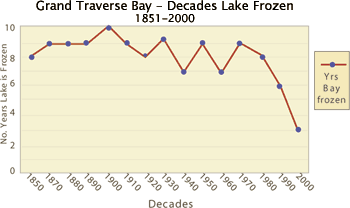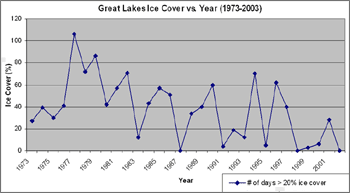Recent Trends in Lake Ice Cover
The Great Lakes have a significant moderating influence on local climates just downwind of the lakes (generally in areas south and east of the lakes). In general, the water temperatures of the lakes respond more slowly to changes in seasonal solar forcing (and seasonal changes in air temperatures) than do the surrounding land areas. During the spring and summer, air temperatures over land surfaces warm more quickly than the lake temperatures. In the fall and winter the reverse is true as lake temperatures cool more slowly than air temperatures and remain relatively warmer than the surrounding land surfaces. There are potential impacts, particularly related to ice cover. Lake-effect snow is greatly diminished once ice cover develops as it reduces or prevents evaporation from open water surfaces. Given trends of warmer winter temperatures during the past few decades, the magnitude and duration of ice cover has decreased significantly as illustrated by the two figures below.
Graph courtesy of Traverse City Record-Eagle
Ice cover on Lake Michigan has decreased significantly since the 1970ís, shown by the graph at the left, which shows the decrease by decade.
RETURN TO: Historical Climate Trends ![]()

